Introduction
Hello, and welcome to the second part of my Belcher primer, in which I’ll focus on how to build your sideboard. If you haven’t checked the first part that covers the maindeck, you can find it here – I highly recommend checking it out before reading this article. All caught up? Great, let’s go then!
Sideboarding with Belcher is relatively easy. Because our kill doesn’t require that much resources, we can afford to have more interaction than you would expect from a typical engine deck – in fact, even the maindeck already has a few flex slots, usually dedicated for broad-ish interactive cards like Pact of Negation, Blood Moon and Fury, or alternatively support tools like March of Reckless Joy. This way we can effectively extend our sideboard capacity beyond the usual fifteen slots, which is invaluable in a format as broad as Modern. If they are not important in the matchup (for example, Pact of Negation is useless if the opponent doesn’t have countermagic), they’re usually the first ones to go to make room for actually good sideboard cards. But what are those exactly? What are the best cards for your sideboard?
The most important goal for sideboard cards in Belcher is to neutralise opponents’ hate cards. The deck is already so focused on executing its main gameplan that it would be challenging to incorporate another line of attack from postboard. Because of that, the main purpose of your sideboard cards is to either protect or enable casting and activating Goblin Charbelcher. The only exceptions to this rule are Blood Moon effects, which are almost a whole new gameplan on their own, and alternative win conditions, usually set up by Recross the Paths when Belcher by itself isn’t good enough (for example against infinite life).
Top tier sideboard options
Magus of the Moon/Blood Moon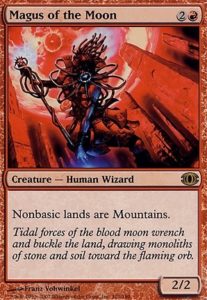
I wrote about Moon effects in the maindeck part of the primer, since, in my opinion, those cards are at their best in game one. Once the opponent are aware of them, they often tend to fetch for basics and take other anti-Moon precautions. But in some matchups, opponents won’t have the luxury of being able to play around this effect, or their manabase (and sometimes even their whole gameplan) won’t allow them to fully neutralise those cards.
The decision between Magus and Blood Moon boils down to how much your opponents will be prepared for either one of them. For instance, if you expect to play a lot vs Force of Negation decks (Living End) or archetypes that focus on Boseiju or Force of Vigor (Amulet), Magus of the Moon is the better choice. This will usually be the case because many players side in disenchant effects to combat Belcher anyway, so diversifying the card types on your threats should force the opponent to sideboard suboptimally. There are some exceptions of course – for example, if you want to prepare to beat Four Colour decks, I recommend having Blood Moons instead, since they have too many removal spells to board all of them out. As a result, cards that can do something more than just kill a creature like Lightning Bolt, Fury, or Solitude will often stay in their deck postboard, so Magus of the Moon won’t be as reliable.
Leyline of Sanctity
Leyline is used to stop effects that target us: discard, burn spells, and Cranial Extraction effects like Necromentia. It can also be a turn zero win against some fringe combo strategies like Storm, Calibrated Blast, or in the mirror if the opponent is not prepared for the effect. If you draw it later in the game, you can still cast it, thanks to Manamorphose and Treasures from Strike it Rich. There’s also Valakut Awakening to replace it with a fresh card if you don’t need it anymore.
Pact of Negation
If you don’t have four copies in the main, you should definitely have the rest of them in the sideboard. Pact gets the job done vs countermagic and shines vs one of the most popular matchups: Murktide decks. But remember, it’s not always the best tool against control – once you commit to using them, there’s rarely a way back due to the steep upkeep cost on it. Because of that, make sure you can win prior to having to pay for it before you pick up the fight. You can also try to rely on other options if the risk of losing to your own trigger is too high or if the opponent has access to four Teferi, Time Ravelers to shut down your countermagic.
Veil of Summer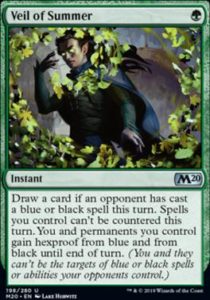
Veil is Belcher’s alternative solution to stop counterspells. It has four very big upsides in counter wars over Pact of Negation:
- Works with Teferi on the battlefield, as you can cast it preemptively before you start comboing off
- Counters all copies of Flusterstorm
- Can protect spells that won’t win the game on the spot like Recross the Paths or Blood Moon
- It makes all your future spells uncounterable until end of turn. This mostly matter in Reforge piles
The price for these upsides is quite high though – to use it we must have access to green mana. It sounds trivial, but in a deck without any dual lands, this can be a challenge.
In terms of protecting against discard, Veil of Summer is not that spectacular in Belcher, mainly because of our bad manabase – even if the Belcher player is starting the game, there are only four lands that will be able to cast Veil on turn one, so the opponent will be able to cast turn one Thoughtseize or Inquisition of Kozilek before we get the chance to use our interaction. Finally, the least utilised, but definitely important use of Veil: it can protect our permanents from black effects like Kolaghan’s Command or Assassin’s Trophy. That’s why it’s usually sided in vs black interaction anyways – it’s just not as good as in other decks.
The cantrip part is a nice bonus, just make sure to take this extra draw into account. Situations like setting up a Reforge pile and accidentally drawing a card from Veil when you didn’t want to because you wanted to protect your permanent is a common mistake made by inexperienced Belcher players.
Force of Vigor
FoV is the best disenchant effect in a wide array of Modern decks, as it can deal with hate cards or opponents’ key permanents for zero mana on top of answering multiple things at once. There are some interactions that are unique for Belcher though. First of all, Force works nicely with our lands – Turntimber Symbiosis and Bala Ged Recovery are green on the front side, so they make our green count higher for pitching purposes. Force also works beautifully with Recross the Paths – after it does its work, Recross comes back to the hand thanks to the Clash mechanic (which we nearly always win thanks to Turntimber Symbiosis), and can be used as a fuel for Force of Vigor. You can also pitch Kaheera, the Orphanguard, assuming you’ve decided to play a Companion.
Tier 1,5
Those options are on par with Tier 1 in regards of their power, but they aren’t as versatile as the options presented above.
Nature’s Claim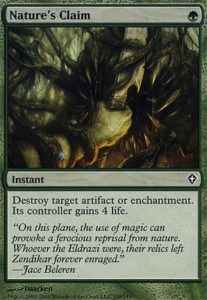
Nature’s Claim is worse than Force of Vigor in most cases. It has only one upside – it’s cheaper to cast on our combo turn after we draw a fresh seven thanks to Reforge the Souls. Reminder: as long as you have three or more lands on the battlefield, you’ll have one extra mana and one card to spare – ideally to cast Nature’s Claim and deal with the hate that’s blocking us from winning the game. Having it as an element for Recross piles lets us combat permanent-based hate like Leyline of Sanctity or Pithing Needle more effectively. Some would say that Pyromancer Ascension loops can do the same and not waste a sideboard slot for a bad card, but this way of dealing with the opponent’s hate is not vulnerable to disenchant effects like Boseju, Who Endures.
Fury
This is Belcher’s best option to deal with hatebears or to slow down the opponent’s creature goldfish if needed. Similarly to Force of Vigor, thanks to flip lands we have an abundance of cards to pitch to it. It’s also the only way I can think of right now to make use of spare copies of Irencrag Feat that would be dead otherwise, as well as naturally drawn Reforge the Souls. Don’t forget about the hardcast mode! Sometimes it can be your only way to win the game if the opponent has somehow blocked your main gameplan. Fury is particularly effective against creatures that can’t be killed with Spikefield Hazard: Meddling Mage, Collector Ouple, Archon of Emeria, etc. It also deals with Lavinia, Azorious Renegade, but you have to be careful there, since you can’t Evoke it due to Lavinia’s static ability. I also don’t recommend siding too many copies to answer Ragavan – do it only if you don’t have anything better to side in.
Gut Shot
A narrow answer to a narrow problem – Ragavan. It’s played because it can be cast for zero mana, which is particularly useful in a deck with multiple taplands. Outside killing Monke, it can deal with a lot of other stuff – mana dorks, Inkmoth Nexus etc. It’s also capable of breaking some fringe combo kills, like Heliod + Spike Feeder/Ballista that’s 2/2, or Conspicuous Snoop + Boggart Harbinger. Note that it can also be used as a zero cmc spell to be countered by An Offer You Can’t Refuse. Playing one in the sideboard vs expected heavy Ragavan field is never a bad idea because if you have only one, you’ll never draw multiples and the card will most likely do something relevant.
Pyromancer Ascension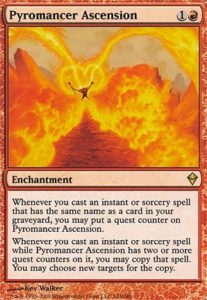
It’s the best alternate win-con for the deck. 97% of the time, it will have to be set up with the help of Recross the Paths. The general idea is to put counters on the Ascension with Manamorphoses and loop Manamorphoses/Rituals and Bala Ged Recoveries to get infinite mana and draw. Once it’s accomplished, you can deal infinite damage with Spikefield Hazards or angels from Emeria’s Call (they gain haste thanks to Song-Mad Treachery). I wrote a separate article about what you can do with Pyromancer Ascension.
The card solves multiple problems the deck has: Karn, the Great Creator, permanent-based hate that stops us from activating Belcher, so Pithing Needle, or Leyline of Sanctity. Its biggest strength is in the fact that it only ‘steals’ one sideboard slot and it guarantees the win, unlike other win conditions like Thassa’s Oracle + Undercity Informer + Collected Company or Empty the Warrens. This plan has one big weakness that other aforementioned plan don’t share: Channel lands. Boseiju, Who Endures and Otawara, Soaring City can deal with an active Ascension and we won’t be able to protect it with our only available tool: Pact of Negation. That’s why if they are heavily played, you can consider cutting Ascension from your deck and focus on other ways of dealing with hate.
Questionable choices and traps
All these cards are weaker than tier options, but it’s ok to know about them, so you’ll be able to adapt to different metagames or understand why they shouldn’t be in your sideboard, even if it’s tempting to have them.
Kaheera, the Orphanguard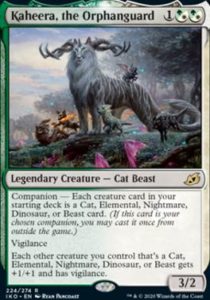
In theory, it’s a free addition to the deck. Belcher usually doesn’t have any creatures in the maindeck, and it even works with the sideboarded Furies. Kaheera does a couple different things for the deck – it’s a green card for Force of Vigor, and it’s also a way to trick the opponent that we are playing something else, like UW Control or Elementals. In my opinion, the bluff element of the card doesn’t give us much – if the opponent thinks that we are playing UW, they won’t keep heavy removal hands anyways, and will value things that are good against Belcher as well – countermagic, discard and threats. I also don’t believe that having a 3/2 for six mana total as the only creature played would ever win a game of Magic. That’s why I’m not the biggest fan of playing Kaheera and Belcher can be a rare case when having a fifteenth sideboard slot can be worth more than the upside Kaheera offers.
Lightning Bolt/Dismember
Oldschool removal spells of choice to deal with hatebears. Useful in metagames where instant speed removal is very important or when Fury can’t do the job – for instance vs Lavinia. They are probably not good enough to see the play, but it’s worth keeping them in mind.
Defense Grid
Before Modern Horizons 2, it was used in control matchups to force the counterspell use before the Blecher cast. Nowadays, there are enough catch-all effects to deal with it without having to sideboard anything dedicated for it – Prismatic Ending is the main culprit here. Even against non-white countermagic decks, like UR, it’s not as good as it used to be – Ragavan can produce enough Treasures that paying additional three for a game-winning Counterspell won’t be the same issue as it was before.
Madcap Experiment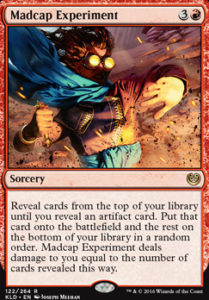
A ‘5th Belcher’ that can kill you from time to time. It’s definitely a wild one, but the idea behind it is fairly sound – having more must-counter spells vs control decks sounds enticing in theory. I’m not a fan of it in practice though, but maybe there will be a metagame that’s right for it at some point somehow.
Engineered Explosives
Kind of a catch-all vs low cmc decks which can also play Pithing Needle, as well as Rhinos. I’m not a fan of it because it’s mana intensive and can be affected by some hate cards like Collector Ouphe, but I can imagine metagames in which it’s playable as a 1 or 2 off.
Mountain
A way to decrease the impact of any type of mana denial plan. If you expect many Boseijus, Ghost Quarters/Field of Ruins + Cleansing Wildfires, it can be ok to play one copy. But there’s a risk with adding a ‘real’ land to the deck. The most problematic is messing up Recross piles – after all, stacking the deck with Recross is a vital part of the deck, and you won’t be able to do so with an actual land in your library. Another problem is the actual Belcher activation – there’s a risk that you won’t kill if the Mountain will be somewhere close to the top of your deck. The worst possible outcome is when you have Pact of Negation trigger on the stack and you fail to kill the opponent and lose to the upkeep cost shortly after. In my opinion, Mountain is a playable option, but you should think five times before adding it to you deck and then another five before siding it in. There’s a risk that the opponent won’t draw their land destruction, especially if they have four or less of these effects, and your Mountain will cause you more troubles than would help. In practice, basic Mountain should be considered as an option in weird local metagames infested with White Taxes and Boseiju, but at this point, you probably shouldn’t play Belcher in the first place.
That’s everything for today, in the next chapters I’ll talk through gameplay aspects and details on building the Recross the Paths piles.
